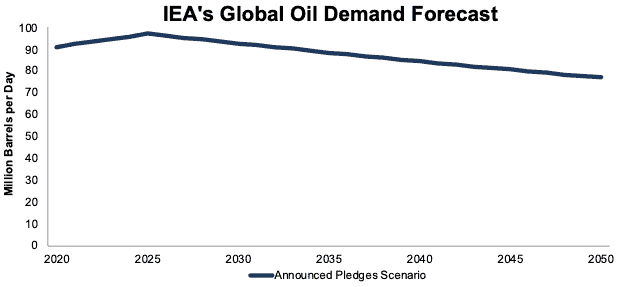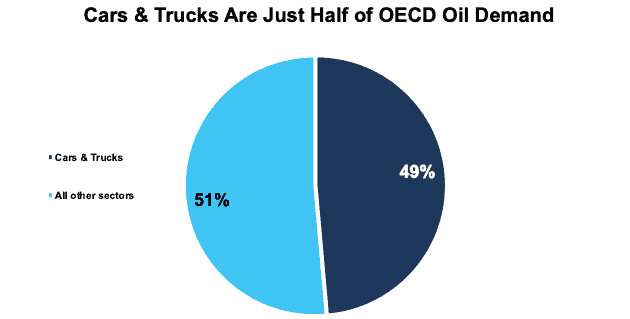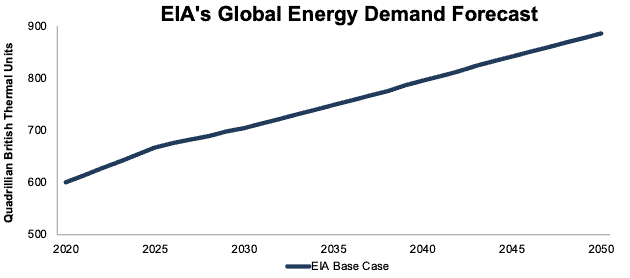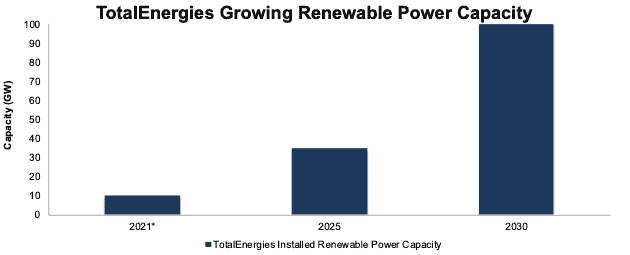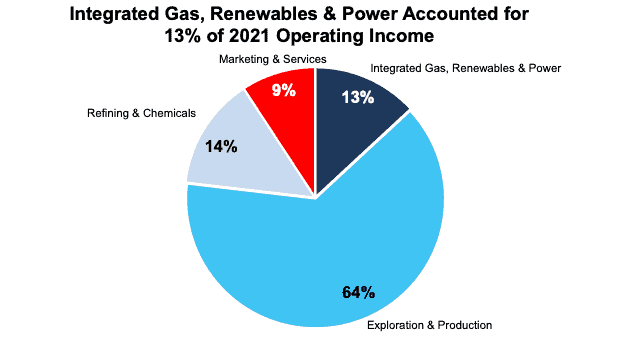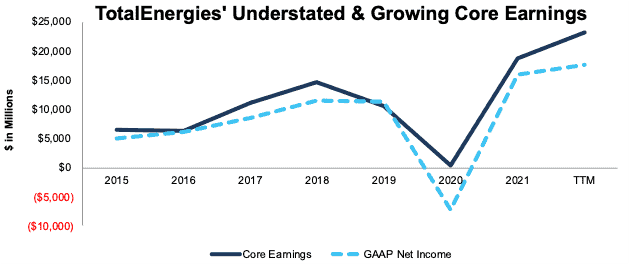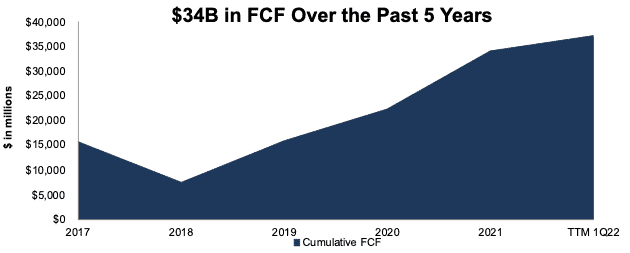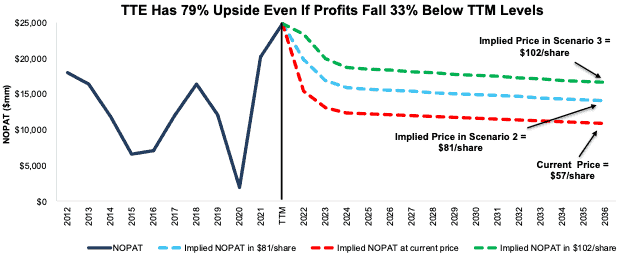We published an update on TTE on March 9, 2023. A copy of the associated Earnings Update report is here.
We provide a brief update addressing recent legislation in Europe and its impact on TTE here.
The Russia/Ukraine war continues to shine a spotlight on the importance of fossil fuels to the global economy. While benefitting from higher oil prices brought on by Russian oil sanctions, this company offers investors much more than a short-term oil play. TotalEnergies SE (TTE: $57/share) is well-positioned to supply growing energy and petrochemicals demand for decades and is this week’s Long Idea.
TTE presents quality risk/reward given the company’s:
- multi-energy strategy that positions the company for long-term growth in energy markets
- superior profitability to peers
- strong free cash flow (FCF) generation to fund alternative energy investments
- shares are worth $102+ even if profits fall 33% from current levels
Fossil Fuels Still Have a Big Future
Demand for crude oil will persist for decades, which appears to be a fact forgotten by many investors, given the undervalued prices of many energy firms, such as Petrobras (PBR), Shell (SHEL), Phillips 66 (PSX), HF Sinclair (DINO), and TotalEnergies.
According to the International Energy Agency’s (IEA) most recent announced pledges scenario (APS), global crude oil demand will rise until 2025 before falling 1% compounded annually from 2026 to 2050. This scenario means crude oil demand in 2050 is just 16% below 2021 levels.
However, the APS demand scenario is likely overly optimistic in its assumptions of the world’s ability to transition away from crude oil dependence. As we pointed out in our report on Shell, climate pledges with no repercussions are very unreliable. Indeed, at the beginning of 2022, the IEA raised its 2022 demand forecast to 99.7 m/bpd, which is well above the peak crude oil demand in its APS forecast of 97 m/bpd in 2025. It should be noted that the IEA forecasts are notorious for taking the current price of oil and projecting it to perpetuity, resulting in long-term demand forecasts that swing back and forth with the winds of current demand.
Figure 1: IEA Crude Oil Demand Forecast: Announced Pledges Scenario Through 2050
Sources: New Constructs, LLC and IEA
Russia Sanctions Open the Door to Long-Term Opportunity…
Before the war in Ukraine, Russia supplied the EU with ~25% of its crude oil imports in 2020 and 41% of its natural gas imports in 2019. The sanctions on Russia remove multiple large state-affiliated competitors in Europe, providing a much more favorable operating environment for supermajors such as TotalEnergies.
Europe is already looking to source its energy needs elsewhere, and the U.S. has agreed to ship an additional 15 billion cubic meters of LNG to Europe by the end of 2022. The increased demand for U.S. LNG benefits TotalEnergies, which operates the second largest publicly traded LNG business in the world and accounted for ~10% of all U.S. LNG exports in 2021.
Down the line, TotalEnergies is positioned to benefit from increased investments in North Africa, the Mediterranean, and the Middle East as Europe drives to replace Russian oil.
…and Are Already a Net Gain
Recent sanctions inhibiting the export of liquid natural gas technology threaten TotalEnergies’ Russian investments. The company deployed $13.7 billion of capital in Russia before its recent $4.1 billion write-down in 1Q22. However, TotalEnergies is not the only supermajor that made a bad bet in Russia. The combined write-downs of the five largest supermajors’ exit from Russia totaled $34 billion in 1Q22.
Nonetheless, the large increase in fossil fuel prices since the beginning of the war in Ukraine more than offsets TotalEnergies’ exposure to Russia. The company’s Russian upstream assets accounted for just 2.5% of total operating cash flow (before working capital changes) in 1Q22. Despite an 82% year-over-year (YoY) fall in operating cash flow from Russian upstream assets in 1Q22, operating cash flow from all segments soared 117% YoY.
EVs Don’t Affect Demand for Fossil Fuels as Much as People Think
The growth of internal combustion engine (ICE) vehicles over the next three decades will contribute to sustained demand for oil and gas products. Even if the world adopts electric vehicles (EVs) in line with the EIA’s expectations, there will still be ~15% more ICE vehicles on the road in 2050 than in 2020. In addition, analysis on the EV market frequently ignore the number of diesel-fueled heavy engines needed to dig the minerals needed for batteries out of the ground and move the components back and forth during refining and manufacturing.
The EIA estimates the entire global light-duty vehicle fleet will grow from 1.3 billion in 2020 to 2.2 billion in 2050 and expects 31% of the global light-duty vehicle fleet to be EVs. Despite the significant growth in the percentage of EVs on the road, ICE vehicles will account for 1.5 billion vehicles in 2050, or two million more ICE vehicles than were on the road in 2020.
Even more importantly, cars and trucks only account for 49% of all crude oil demand for Organization for Economic Co-operation and Development (OECD) countries, per Figure 2. More than half of crude oil demand stems from other segments that are vital to economic development including petrochemicals, commercial, agriculture, aviation, marine shipping, electricity generation, and rail transportation.
Figure 2: Distribution of Crude Oil Demand by Sector in OECD Countries: 2020
Source: New Constructs, LLC and Statista.
With or Without Oil, Global Energy Demand Will Growth
Even if global demand for crude oil eventually declines, demand for energy will not, and natural gas will inevitably play a large part in the transition away from crude oil and coal.
Figure 3 shows the U.S. Energy Information Administration’s (EIA) base-case scenario for global energy (coal, crude oil, natural gas, electricity, and renewables) demand from 2020 through 2050. In this scenario, the EIA expects energy demand to grow 47% over the next three decades, with demand for natural gas growing 31% from 2020 to 2050.
Figure 3: EIA Energy Demand Forecast: Base Case Through 2050
Sources: New Constructs, LLC and EIA.
Natural Gas Is a Cleaner Energy
The trade-off for being “cleaner” is that the energy density of methane, the primary component of natural gas, is much lower than coal. The world found a solution to this dilemma in liquification.
TotalEnergies has quickly grown its liquified natural gas (LNG) business to take advantage of the growing demand for natural gas. TotalEnergies’ LNG sales grew from 15.6 million metric tons (Mt) in 2017 to 42 Mt in 2021, or 28% compounded annually.
The company has several projects in the works that will increase its LNG capacity. These projects include:
- Tyra natural gas with 60,000 boe of annual capacity
- Ichthys LNG JV with 8.9 Mt of annual capacity
- Cameron LNG JV extension with 6.8 Mt additional annual capacity
Renewable Energy Drives Production Growth
Though crude oil is a significant part of its business, the company is focused on transitioning away from its reliance on it. TotalEnergies’ crude oil product sales fell from 65% of all sales in 2015 to just 44% in 2021.
While the growth of the company’s natural gas and LNG business have most significantly contributed to its ability to shift away from crude oil, TotalEnergies also aims to quickly grow its renewable energy (solar, wind, biogas, and biofuels) business. Per Figure 4, TotalEnergies plans to increase its installed renewable power capacity by ~10x, from 10.3 GW in 2021 to 100 GW in 2030, or 1.7x the installed capacity of France’s nuclear plants.
Figure 4: TotalEnergies’ Renewable Power Capacity Goals
Sources: New Constructs, LLC and company filings.
*Actual
EV Is an Opportunity, Not a Threat
TotalEnergies’ global presence and experience in managing large energy projects position the company to scale its emerging EV charge point business. TotalEnergies operates in 130 countries across the globe and has nearly 16,000 service stations, which it can leverage to add more charge point capacity. The company plans to grow the number of charge points it operates by 6x, from ~25,000 in 2021, to 150,000 in 2025.
Below are some of the locations and number of TotalEnergies’ charge points in operation or under construction:
- Greater Amsterdam, the Netherlands – 22,000
- Wuhan, China – 11,000
- Antwerp, Belgium – 3,000
- Paris, France – 2,300
- London, England – 1,700
- Singapore – 1,500
Record Profits Come with Political Risk
Fossil fuel companies reported record profits in 1Q22 in the wake of the war in Ukraine, and the large windfall is drawing attention from governments, especially in Europe. The European Commission is proposing EU members tax fossil fuel profits to fund renewable energy measures. However, given TotalEnergies’ growing investment in renewable electricity, the company is positioned to benefit from increased tax-funded incentives even if it comes at the expense of its fossil fuel-driven profits.
Even before the Ukraine war, France was investigating the feasibility of taxing profits from fossil fuel companies to assist countries lacking energy resources. However, if such a tax were to pass, it would likely affect the entire industry, and not just TotalEnergies. In commenting about the proposal, the French economy minister stated, “We can’t penalise just Total to the benefit of other big oil groups who would not be subject to this constraint.”
Though the discussion of windfall taxes may make nice headlines for politicians, in actuality, they are likely to be limited if implemented. Excessive taxation on fossil fuel companies is ultimately not in the best interest for Europe, especially now, and would dampen its efforts to become independent from Russian energy.
Alternative Energy Investments Are Paying Off
TotalEnergies’ investments in LNG, electricity, and renewable energy significantly contribute to the company’s operating income. TotalEnergies’ Integrated Gas, Renewables and Power segment’s operating income has grown from $226 million in 2017 to $3.4 billion in 2021. In 2021, this segment accounted for 13% of total operating income, up from just 1% in 2017.
Figure 5: TotalEnergies’ Operating Income by Segment: 2021
Sources: New Constructs, LLC and company filings.
More Profitable Than Peers
TotalEnergies has effectively invested its capital as it pursues a long-term transition away from crude oil. Its net operating profit after-tax (NOPAT) margin has risen from 8% in 2017 to 11% over the trailing twelve months (TTM), while its invested capital turns improved from 0.8 to 1.0 over the same time. Rising NOPAT margins and invested capital turns drive the company’s return on invested capital (ROIC) from 6% in 2017 to 11% TTM.
TotalEnergies’ ROIC of 11% over the TTM is second only to Eni (E) among all supermajor peers. See Figure 6.
Figure 6: TotalEnergies’ Profitability Vs. Supermajors: TTM
Sources: New Constructs, LLC and company filings
Core Earnings Are Understated
TotalEnergies’ profitable legacy fossil fuel business helped the company generate positive Core Earnings in each of the past 10 years. However, the company has grown its Core Earnings even as it has transitioned more of its business away from crude oil products. TotalEnergies grew Core Earnings from $6.6 billion in 2015 to $23.3 billion over the TTM.
Not only are TotalEnergies’ Core Earnings growing, but they are higher than GAAP earnings. Over the TTM, TotalEnergies’ Core Earnings are $5.7 billion, or 32%, higher than GAAP earnings, per Figure 7.
Figure 7: TotalEnergies’ GAAP & Core Earnings Since 2015
Sources: New Constructs, LLC and company filings.
TotalEnergies’ Free Cash Flow Supports Alternative Investments
TotalEnergies generates significant cash flow that the business can use to fund the expansion of its LNG, renewables, and power generation operations. Over the past five years, TotalEnergies generated $34.1 billion (24% of market cap) in free cash flow (FCF), which is 1.3x ConocoPhillips’ (COP), 1.8x Eni’s, and 96% of BP’s (BP) five-year cumulative FCF.
Figure 8: TotalEnergies’ Cumulative Free Cash Flow Since 2017
Sources: New Constructs, LLC and company filings
TotalEnergies’ Stock Is Cheaper Than Peers
Even though TotalEnergies is consistently profitable, generates strong FCF, and is well-positioned to meet future global energy demand, its stock is priced for permanent profit decline and is cheaper than its peers’. The company’s price-to-economic book value (PEBV) three-year average ratio[1] of 0.6 means the stock is priced for profits to fall, permanently, by 40% from its average over the last three years.
Figure 9: TotalEnergies’ 3-Year Average PEBV Ratio Vs. Peer Group
Sources: New Constructs, LLC and company filings
*Peer group includes same companies listed in Figure 6
Below we use our reverse discounted cash flow (DCF) model to analyze the future cash flow expectations baked into TotalEnergies’ stock price. We also provide an additional scenario to highlight the upside potential in shares if TotalEnergies grows revenue at consensus rates.
DCF Scenario 1: to Justify the Current Stock Price.
We assume TotalEnergies’:
- NOPAT margin falls to 7% (5-year average from 2015-2019 vs. 11% TTM) in 2022 through 2036, and
- revenue falls at a 2% CAGR from 2022 - 2036 (vs. consensus estimate of +4% CAGR from 2022 - 2024)
In this scenario, TotalEnergies’ NOPAT falls 4% compounded annually over the next 15 years and the stock is worth $57/share today – equal to the current price. In this scenario, TotalEnergies earns $11 billion in NOPAT in 2036, which is 56% below TTM levels and 11% below its 10-year average NOPAT.
DCF Scenario 2: Shares Are Worth $81+.
If we assume TotalEnergies’:
- NOPAT margin falls to 7%,
- revenue grows at a 4% CAGR from 2022 – 2024 (equal to consensus estimate CAGR from 2022 – 2024), and
- revenue falls at a 1% CAGR from 2025-2036 then
TTE is worth $81/share today – a 42% upside to the current price. In this scenario, TotalEnergies’ NOPAT still falls to $14.1 billion in 2036, or 44% below TTM levels. In this scenario, TotalEnergies’ ROIC in 2036 is just 4.9%, which is well-below its 10-year average ROIC of 6.3%. Should TotalEnergies’ ROIC remain in line with historical levels, the stock has even more upside.
DCF Scenario 3: More Upside Should Margins Remain in Line with Peers
Each of the above scenarios assumes TotalEnergies’ NOPAT margin immediately falls to its pre-COVID five-year average, which is 29% of ConocoPhillips’, 54% of ExxonMoblil’s (XOM), and 87% of BP’s TTM NOPAT margins. At 7%, TotalEnergies’ NOPAT margin from 2022 – 2036 would be 15% below the pre-COVID three-year average NOPAT margin of its peer group from 2017 to 2019. Should the company’s margins fall in line with pre-COVID peer levels, the stock has even more upside.
If we assume TotalEnergies’:
- NOPAT margin falls the three-year peer group average from 2017-2019 of 8%,
- revenue grows at a 4% CAGR from 2022 – 2024 (equal to consensus estimate CAGR from 2022 – 2024), and
- revenue falls at a 1% CAGR from 2025-2036 then
TTE is worth $102/share today – a 79% upside to the current price. In this scenario, TotalEnergies’ NOPAT in 2036 is $16.6 billion, or 33% below TTM levels.
Figure 10 compares TotalEnergies’ historical NOPAT to the NOPAT implied in each of the above DCF scenarios.
Figure 10: TotalEnergies’ Historical and Implied NOPAT: DCF Valuation Scenarios
Sources: New Constructs, LLC and company filings.
Sustainable Competitive Advantages Will Drive Shareholder Value Creation
Here’s a summary of why we think the moat around TotalEnergies’ business will enable it to continue to generate higher NOPAT than the current market valuation implies. The following competitive advantages also help TotalEnergies grow in a transitioning market:
- engineering and project management expertise
- large physical network of 16,000 services stations and 25,000 EV charge points across the globe
- large cash-flow generating business to fund new investments
- high profitability compared to peers
What Noise Traders Miss With TotalEnergies
These days, fewer investors focus on finding quality capital allocators with shareholder friendly corporate governance. Instead, due to the proliferation of noise traders, the focus is on short-term technical trading trends while more reliable fundamental research is overlooked. Here’s a quick summary of what noise traders are missing:
- the persistence of global dependency on fossil fuels
- long-term rise of global energy demand
- growth potential within TotalEnergies’ LNG and renewable energy projects
- valuation implies TTE is relatively much cheaper than the stocks of other supermajor peers
Earnings Beats and a Sustained Oil Prices Could Send Shares Higher
TTE earns our Beat Earnings Distortion Score because GAAP earnings materially understate Core Earnings. This score indicates that TotalEnergies has a high likelihood of beating earnings estimates for 2Q22. TotalEnergies has beaten earnings estimates in nine of the past 10 quarters and doing so again could send shares higher.
Russia invaded Ukraine at the end of February 2022, and since March 2022, the price of Brent crude oil has consistently closed above $100. Should oil prices persist at their current elevated levels, TotalEnergies profits and share price could continue to soar.
Dividends and Share Repurchases Could Provide 7.1% Yield
TotalEnergies has paid a dividend in every year since 2012. Since 2017, TotalEnergies has paid $29.1 billion (21% of current market cap) in cumulative dividends. The company’s current dividend, when annualized, provides a 5.2% yield.
TotalEnergies also returns capital to shareholders through share repurchases. From 2017 to 2021, the company repurchased $9.6 billion (7% of current market cap) of stock. TotalEnergies has repurchased $2.8 billion over the TTM. If the company continues to repurchase shares at the same rate, the buybacks will provide an annual yield of 1.9% at its current market cap.
Executives’ and Shareholders’ Interests Are Aligned
No matter the macro environment, investors should look for companies with executive compensation plans that directly align executives’ interests with shareholders’ interests. Quality corporate governance holds executives accountable to shareholders by incentivizing them to allocate capital prudently.
Part of the company’s variable compensation in 2021 was based on a return on average capital employed (ROACE) target, which is a positive for investors. The company calculates capital employed as “the net adjusted operating income divided by the average of the capital employed (at replacement costs, net of deferred income tax and con-current liabilities)”.
Tying executive compensation to ROIC, or something similar like ROACE, ensures that executives’ interests are actually aligned with shareholders’ interests as there is a strong correlation between improving ROIC and increasing shareholder value.
TotalEnergies’ focus on creating shareholder value has helped it grow economic earnings from $1.1 billion in 2017 to $14.8 billion over the TTM.
Insider Trading and Short Interest Trends
There is no data available related to insider transactions.
There are currently 4.9 million shares sold short, which equates to <1% of shares outstanding and under one day to cover. Short interest is up 24% from the prior month. The lack of short interest reveals not many are willing to take a stake against this free cash flow generator.
Critical Details Found in Financial Filings by Our Robo-Analyst Technology
Fact: we provide more reliable fundamental data and earnings models – unrivaled in the world.
Proof: Core Earnings: New Data & Evidence, forthcoming in The Journal of Financial Economics.
Below are specifics on the adjustments we make based on Robo-Analyst findings in TotalEnergies’ 20-F and 6-Ks:
Income Statement: we made $9.3 billion of adjustments, with a net effect of removing $4.2 billion in non-operating expenses (2% of revenue). Clients can see all adjustments made to TotalEnergies’ income statement on the GAAP Reconciliation tab on the Ratings page on our website.
Balance Sheet: we made $97.0 billion of adjustments to calculate invested capital with a net increase of $22.2 billion. One of the largest adjustments was $30.3 billion in asset write-downs. This adjustment represented 15% of reported net assets. Clients can see all adjustments made to TotalEnergies’ balance sheet on the GAAP Reconciliation tab on the Ratings page on our website.
Valuation: we made $111.4 billion of adjustments to shareholder value for a net effect of decreasing shareholder value by $49.5 billion. Apart from total debt, one of the most notable adjustments to shareholder value was $30.1 billion in excess cash. This adjustment represents 21% of Total’s market cap. Clients can see all adjustments to TotalEnergies’ valuation on the GAAP Reconciliation tab on the Ratings page on our website.
Attractive Funds That Hold TTE
The following funds receive our Attractive rating and allocate significantly to TTE:
- Prudential Investment Portfolios (JDEZX) – 3.0% allocation
- Sound Equity Income ETF (SDEI) – 2.8% allocation
This article originally published on May 25, 2022.
Disclosure: David Trainer, Kyle Guske II, and Matt Shuler receive no compensation to write about any specific stock, style, or theme.
Follow us on Twitter, Facebook, LinkedIn, and StockTwits for real-time alerts on all our research.
[1] For this analysis, we calculate PEBV ratio as market cap / three-year average EBV. Using three-year average EBV provides a more normalized EBV after the record drop in profits in 2020 and subsequent rise in 2021.

